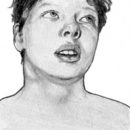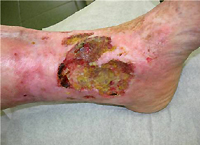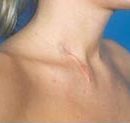Reinforced heartbeat, sweating, irritation, trembling hands, increased thyroid gland - these are the main characteristics of the person who overtook the disease of the thyroid. What treatment methods exist? What is thyroidectomy? Answers to these questions you will find in the article.
Content
Treatment of thyroid gland
According to the leading domestic and world endocrinological centers today, various endocrine and non-endocrine diseases of the thyroid gland have a resistant tendency to increase. A few decades ago in the structure of the morbidity prevailed the diseases of the thyroid gland associated with the deficit of iodine (endemic goiter, Basedov disease, etc.). Currently, the main percentage in the structure of the morbidity occupies the nodal rebirth of the thyroid gland, including malignant. Treatment of thyroid diseases can be conservative (therapeutic), operational (surgical) and complex (use of both methods).
Thanks to numerous and perennial research of doctors, clear indications have been developed to select one or another method of treating each type of thyroid pathology. The choice of treatment is based on the analysis of the history of the disease, data of additional studies (indicators of hormonal status, ultrasound, scintigraphy, puncture, etc.), analysis of the effectiveness of previously conducted treatment.
No doubt, the therapeutic method for the absolute majority of patients is desirable and preferable before surgery, however, in many cases, only a timely executed operation helps to get rid of the disease. Preferably, if the question of surgical treatment will be solved jointly by a surgeon doctor and an endocrinologist, familiar with the patient's disease. This will make it objectively to address the issue of surgical intervention, to develop adequate tactics of preoperative preparation and postoperative observation.
The following categories of patients are subject to compulsory surgical intervention:
 Patients with a diagnosis of thyroid cancer (timely operation in 95% of cases completely eliminates the disease)
Patients with a diagnosis of thyroid cancer (timely operation in 95% of cases completely eliminates the disease)
- Patients with the presence of nodal formations of the thyroid gland of any size and quantity suspicious about possible illustrative (according to ultrasound, scintigraphy and puncture)
- Patients with fast-growing nodal formations (an increase in the node 2 times in six months.)
- Patients with nodal formations of more than 3.0 cm. Regardless of the results of puncture
- Patients with nodal formations against the background of chronic autoimmune thyroiditis (increased risk of tumor development)
- Patients with the presence of nodal formation of a thyroid gland causing increased emissions of hormones to the body (thyrotoxic adenoma)
- Patients suffering from an increase in the function of the thyroid gland (thyrotoxicosis) in case of unsuccessful therapeutic methods of treatment
- Patients who have an increase in the thyroid gland (diffuse, or associated with the presence of nodes) causes difficulties in breathing and swallowing
The survey before the operation aims to study the function, the structure of the thyroid gland, with the presence of nodal formations morphological studies of the gland fabric (puncture). Based on the data obtained, the testimony for surgical treatment is determined, and the intended volume of operation is determined. A outpatient examination of the cardiovascular, pulmonary system, a study of general and biochemical blood tests is carried out before hospitalization. According to the testimony, operational interventions are performed at any time of the year. A small number of bed-days (on average up to 4), the absence of strict restrictions on physical exertion and the minimum amount of dressings in the postoperative period provide easy tolerance of intervention even during the summer period.
Thyroidectomy
Operations on the thyroid gland are performed under general anesthesia (anesthesia), which provides the best treatment results, reduces the risk of complications, reduces the degree of emotional patient injury. The volume of operation is determined by the nature of the gland lesion, in some cases age and patient floors.
Currently, the minimally permissible operation on the thyroid gland is considered hemitireoidectomy (removal of one share of the entire share), maximum - thyroidectomy (removal of the entire gland). Previously sparing operations in the form of a separate removal of nodal formations, with the leaving of the so-called «Healthy» parts of the thyroid gland are recognized by vicious, since most patients soon are forced to be repeated interventions due to emerging node rebirths in the operated parts of the gland. At the end of the operation, a cosmetic seam is superimposed by the patient in all cases. Modern suture materials allow you to achieve excellent healing results in most patients.
Postoperative period
Within 10 days after surgery, the patient periodically visits the surgeon to observe the scar healing process. By this time, the results of the morphological study of remote fabrics (histology) becomes known. Depending on the volume of operation and histological diagnosis, hormonal treatment is prescribed, the objectives of which are compensation for lost thyroid functions and the prevention of the growth of new nodal formations in the remaining tissues. Hormonal treatment is carried out under the supervision of an endocrinologist to generate an individual dose of the drug, which will accurately correspond to the volume of remote tissues of the gland. After the selection of the individual dose of hormones, the patient is subject to dynamic observation of the endocrinologist with an interval of 1 time in 6 months.
Patients easily carry interference on the thyroid gland and quickly restore the forces. Operation leaves minimum traces and side effects. Despite this, the operations on the thyroid gland are among the most difficult and delicate in surgical practice, so when choosing a hospital for treatment, it should be found out if this institution has all the necessary means for conducting such interventions. Operating surgeon must have sufficient qualifications and experience. Before the treatment began, the patient in a personal conversation with the doctor must ask all the questions you are interested in, to determine the timing and time of hospitalization, the planned volume of operation and postoperative treatment options. On the recommendation of the doctor's doctor, the patient can choose the most convenient hospitalization time for it.









